Ready your pipes, it’s time for more Goemania, as I slowly continue to climb the mountain of conflict that is Goemon.

- Ganbare Goemon: Sarawareta Ebisumaru! (1991) (Gameboy)
- Ganbare Goemon Gaiden 2: Tenka no Zaihō (1992) (NES)
- Ganbare Goemon 2: Kiteretsu Shougun Magginesu (1993) (SNES)
- Ganbare Goemon 3: Shishijyūrokubei no Karakuri Manji Katame (1994) (SNES)
- Ganbare Goemon Kirakira Dōchū: Boku ga Dancer ni Natta Wake (1995) (SNES)
6) Ganbare Goemon: Sarawareta Ebisumaru! (1991) (Gameboy)
This game came out the same year as the first SNES entry and I’m playing the localized version of this game via the Konami Collection Volume 3 on a Gameboy color, so it’s fancy and pretty, just like we like. The title for the game during the opening crawl is just “Starring Goemon“, but the title screen itself shows “Mystical Ninja Staring Goemon” which is a little better but still an odd choice. The Japanese subtitle for the game is “Kidnapped Ebisumaru” and the plot is just that. Ebisumaru has been… kidnapped!
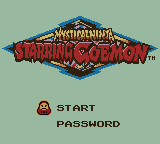


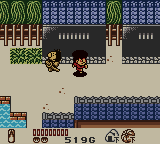
Basically the same Ganbare Goemon for the NES. You get money for defeating enemies, no longer a need to chase anything down after a kill. Jumping near purses or pots spills their contents for you. This game is really easy and also kinda easy to get lost in. You have to adapt a little to it’s visual rules of where you can go as a screen-transition and where you can’t.




How are all of these Goemon games so pretty? I think I gasped when I saw the snow falling animation, but hey I’m easy. Lots of very distinct landscapes which always pack a punch to me when coming from the gameboy screen. Something about the limited screen size makes ’em really have to work to give you the scale they want to convey. This does a decent job of it, and some of it’s visual quirks get a little better near the end of the game when you’re in a dense city. It feels a lot tighter because of how narrow the path is and how many roofs we start seeing near the bottom half of the screen, creating tighter alleyways.
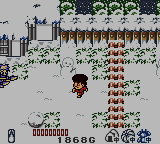
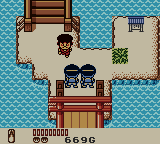


There’s a section where you’ve been poisoned and have to play as a girl named Miko to get a cure from a giant hermit crab monster. This is both a neat part of the game and the worst part of the game. The platforming you’re required to do to get through this ocean section is very unforgiving so I hope you’ve learned how jumping (namely, stopping your jump) works. Not only that, you’re supposed to be gathering up 5 pearls which are invisible until you are right next to them and they are not placed in obvious “pearl here!” spots. If you’re missing one, you gotta go through the whole section again to find it.

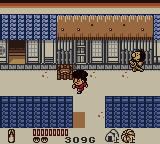
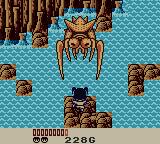

Actually, once you bring the pearls to the sea creature and get the medicine to fix Goemon, you STILL have to backtrack through this section anyway. So frustrating, I need a bath. Thank goodness another Goemon staple is healing at bath houses, usually with the option of going into the men’s or women’s side. Going into the men’s side is full health once you jump in the water, but going into the women’s side is a delightful cut-scene that costs you .. nothing, in this game. While Ganbare Goemon 2 would take half your health for this perversion, you suffer no loss here which I find a shame. A scene this fun needs a greater cost than just 30 ryo. They’ve been teasing idea of seeing something for games now, so to get it for basically free feels dirty. I still need a bath.
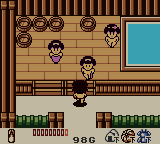



The last boss is beat differently than every other boss in the game which at first I was excited for and thought was neat but in practice it’s a fucking nightmare that I want no part of. Instead of hitting him, he would throw a fan at you what would kind of gravitate around your body trying to hit you. You’d have to walk around while it was circling you and try to get it to bop him in the face. Either I’m just terrible or it’s a little bugged, but half of those hits didn’t seem to register. I can’t imagine the frustration you’d have as kid with that fight, which comes at the end of a grueling section.




7) Ganbare Goemon Gaiden 2: Tenka no Zaihō (1992) (NES)
The second and last(?!) RPG in the Ganbare Goemon series, this one’s translated subtitle is “Treasures of the World“. Okay, I really liked this one. It improved all the stuff I complained about with the last game We got better menus, easier to read equipment information, items to increase MP outside of town, the works. Like, a proper RPG would. You unlock one new menu option from a Tanuki that allows you get information on your items, such as who can equip what or “Try using this item in battle!”. After unlocking him, while in a store he’ll appear next to the party member who can equip what you’re currently looking at. It’s a little clunky, but at least it’s some kind of guide.
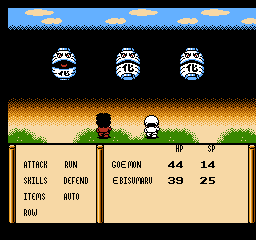

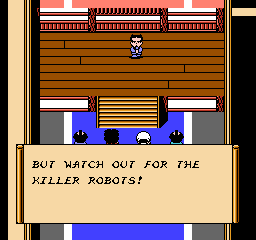

The plot is that there is a tournament of thieves happening in a distant land, so we charter a boat and join in. It starts with a qualifying round where everyone is supposed to gather an Elephant statue from a shrine in town. Only four (Goemon and Ebisumaru count as one here) manage to move on to round two of this contest: collecting 8 keys. Immediately after trying to leave, one of the other contestants blows up the bridge to the rest of the map, causing you to find an alternate way around. Super rude! I love this rat-racey idea of getting in each others way to be first.


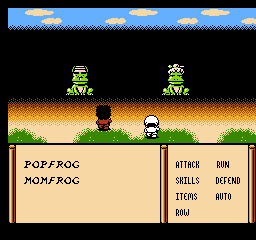
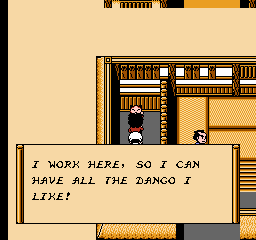
This game is very direct in it’s map design. Very direct. Here is the picture of the map from the games manual, best quality I could find.

Doesn’t do much to stimulate the imagination, but does have this uniquely “video game” vibe to it. With that in mind, I never got lost. I mean, sure I got turned around in a dungeon because I’m a idiot and everything is made of up really big long hallways, but hey it’s an RPG.




Random encounters seem to be cranked to the max. I swear sometimes I go 2 two steps and it’s another fight that I am just running from. I spent a good chunk of the game (more than half) quite a bit over-leveled, and armor didn’t seem to make as huge an impact in this game like it did in the previous Gaiden, but even still I did make it a point to never slack on buying the newest armors. Oddly enough we never quite locked in on a fourth party member for more than a moment.


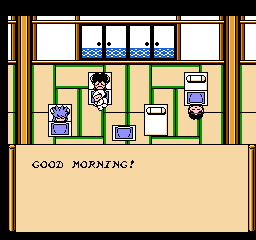

This game also much more engaging with it’s combat, more or less forcing you to use spells and balance out what you’re doing, not just constantly attack, attack, attack, attack. It also introduces Rows, a not uncommon RPG idea of high-attack low-def in the front and high-def low-attack in the back. I found it unnecessary here, just a layer this cake didn’t need. Some sections seem full of enemies to poison you every turn, while another was putting me to sleep constantly. One of neater status effects is inebriation/drunk, complete with an incredible screen wobbly effect that I’m really surprised to see here on the NES.

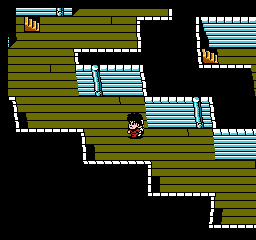
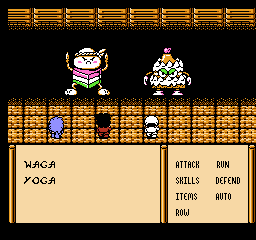

Did we go on a journey again? Hell yeah we did, we even got to ride around in Twinbee and saw that stupid train again with the feet, Jr. It was a lot of fun, I’d possibly recommend this to someone who likes weird obscure overtly charming RPGs.
8) Ganbare Goemon 2: Kiteretsu Shougun Magginesu (1993) (SNES)
We’re back to the Super Famicom again for “Strange General McGuinness“. This game is almost entirely a side scrolling platformer, with town levels being similar to those in previous game. It also marks the first time Sasuke is playable, and that Goemon Impact shows up, pretty big series staples from this point.


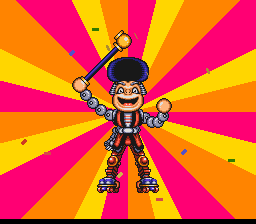


The game is fun, pretty, and sadly very short. Clocking in at 6 worlds and one secret stage accessible after beating the story and finding it hidden away in the games amusement park. The plot of this game is the strange General McGuinness disguises himself a lottery worker and tricks you into a vacation prize outside of Japan, and while you’re out of the way he rigs up Oedo castle to fly away so he can make his own Japan. McGuinness himself is supposed to just represent the idea of ‘not Japanese’ in every way, and not lampooning any particular nationality. He also makes everyone dress in bunny outfits, I’m not.. totally sure what that’s all about, other than it’s really cute.
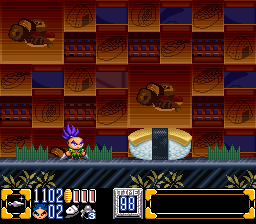

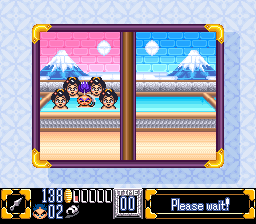
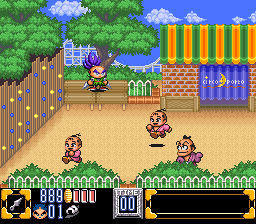
This game handles pretty well. The controls are responsive, but I was often dealing with a little bit of slowdown as the hardware would struggle to keep up just a tad at moments. Not enough to be an issue, but often enough that you notice. I also played almost exclusively as Sasuke, save for the bonus stage that I did as Ebisumaru. They all three start with a different amount of health & money all control a little different, with Sasuke’s weapon upgrade being a ranged attack. The drawback to this is that enemies don’t drop loot when killed from a distance, they instead explode and lose everything. Only with a close-range melee attack will the enemy split in two and drop their goods, that you then have to chase down.

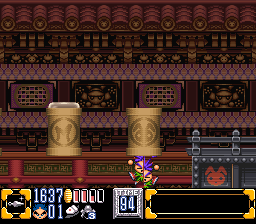



It felt like just about every level had something new for you to be riding on, often with text flashing RIDE right on top of it with an arrow pointing down, just in case you didn’t know. This wasn’t just limited to vehicles like fish-bots, sumo-bots, and minecart-bots that shoot bubbles, but also world obstacles like a dragon you have to jump on and off of as he’s going in and out of the water, or a giant snowball that chases you down a hill and then plops into a pool of water and then slowly gets smaller and smaller as it melts. This game know what it wants you to feel and that is pretty neat.
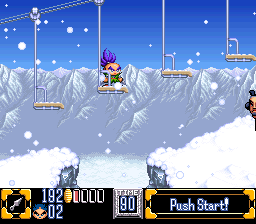
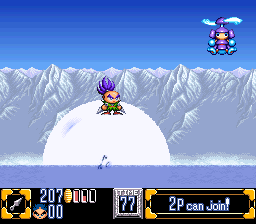

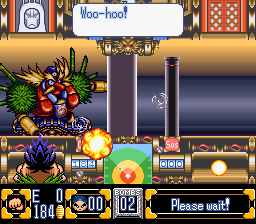

Impact fights! Team Goemon now has the ability to call forth a giant mech named Impact to help solve their problems. These are almost punch-out style first person fights with other giant mechs. I don’t.. feel like I’m very good at these sections. There’s is both a lot going on and also not that much. Busy screen! Basically you just punch the other robot when he’s next to you because shooting your coins at them is often useless and will just result in coins being hurled back in your face. You have to block some of his projectile attacks with either your arms blocking or by hitting/shooting them, with the latter being too much work in practice for me.


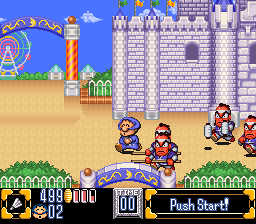
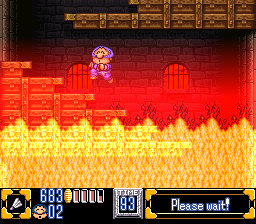

This game’s stages are all very distinct and it had a rocking soundtrack. This is one I can easily say to check out if you get a chance and like the genre.
9) Ganbare Goemon 3: Shishijyūrokubei no Karakuri Manji Katame (1994) (SNES)
This is another entry I was really looking forward to because I knew so little about it and heard only good whispers about it. While it didn’t disappoint, I can’t help but feel like it gets in its own way to start. The plot is that the Wise Old Man has made a time machine and he’s used it to go into the future and check out chicks. He quickly gets captured by a female Ebisumaru look-a-like named Bisumaru, so we head out to try and rescue him.
We start out with a game that feels similar to the first LotMN on the SNES, an overhead town exploring section and a 2d dungeon action sequence. This town part requires a little more work to get through than LotMN by adding in some adventure game elements like needing an inner tube to swim, or unlocking the ability to turn into a mermaid and go under bridges as Yae. This starting level concludes with an incredible mode-7 “running away from a mech in a tiny mech” segment that leaves you at the next stage with no way to backtrack. At this point the game is just ‘unconnected’ stages.




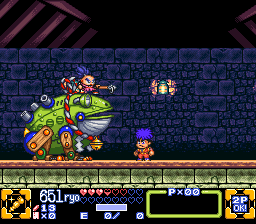
We get Sasuke and, for the first time, Yae as playable characters. You can swap between the four of them at any time with the select button, and if you’re holding Y while you do it you’ll get alternative color palette, making it possible to be classic white clad Ebisumaru. Its required, a lot, to swap between everyone and use their unique abilities to solve platforming puzzles and world problems. After assembling the entire team you run into Bisumaru fresh from the future, who reveals they are working for the main antagonist Jurokube. She kidnaps Omitsu and we have a our first Impact fight of the game.


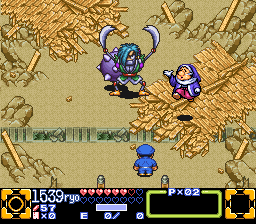


No longer skating and destroying bases for energy, instead we have a strange auto-scrolling side-scroller where you control the giant Impact robot’s up and down position, the way his face is turned, his punching, his shooting (from his face), and if he jumps (which cost like 30 HP and I saw no use for it). I found these sections visually pretty but mechanically lacking. After biffing it a few times (largely due to just jumping myself to death) I found the trick was to just duck down low until you walked the 900 or whatever meters the game wanted, punching building and shooting foreground enemies occasionally if needed. It’s not that the previous ‘rolling through a base’ was more interesting, but it it conveyed “chasing after something” a whole lot better, so this feels a little less than a lateral move.


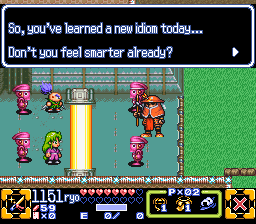
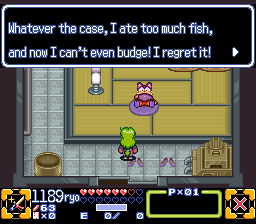
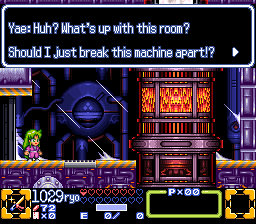
After our first Impact fight the game takes a dramatic shift and throws you into the future, Neo Oedo. It’s at this point that the game starts to shine fully and the visual and mechanical elements it borrows from A Link to the Past come into clearer view. We’re now on the world map for the rest of the game and talking to people for hints on where to go next or what they want for their own quest lines. After unlocking it, you can get a mechanical walker for 10 ryo that you can use to help get around faster and break certain obstacles ‘that no human could break’. The world map is not as action based as ALttP though, probably because it’s so busy dividing it’s attention to side-scrolling sections and mech fights over a hostile overworld.

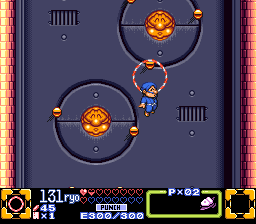

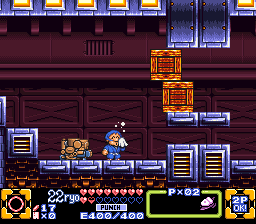
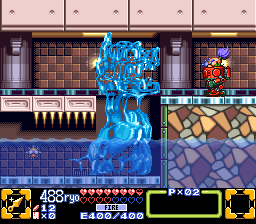
The action sections are a lot more precise and a little unforgiving. They are more puzzle and exploration slanted (complete with fancy Metroid style stage map). The goal isn’t just “get to the end“, its now “get to the end but you better have found all the key items you need or you’re going back to that room you skipped in favor of that other room“. The game encourages this exploration by introducing the idea of collecting 4 Silver Cat statues to get an extra heart container. I sadly missed 2 cats in some of the first dungeons with no way to go back and try again. The game locks you out once you beat them, but once you’re in the future it allows you to go back into a dungeon, so I’m not sure why the game got more forgiving after telling me to eat shit twice. I got really lost in one dungeon because I didn’t notice a missing shadow on one pillar above some water that was trying to indicate to me that I could enter up through there.

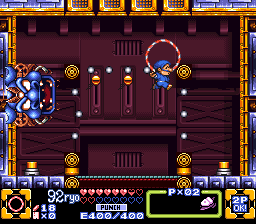

Several of the bosses were more unique than just ‘hit me in the face until I die’. One was a game of Red-Light-Green-Light where you were trying to cut the fuse to a bomb, another had you freezing enemies in your mech walker and then knocking them into him. There was a boss who’d spit monsters out onto this springy ball platform and you’d have to pull levers with your hula-hoop to slingshot enemies back into his face. Or one that was a fire face and an ice face on each side of the wall shooting lasers at you with a device on the ceiling shooting fire and ice shots at you as well and so you had to grab this little triangle mirror object and reflect the shots into the proper face because shooting the wrong face would cause them do a special attack against you, and every 10 seconds or so the three of them do a big lighting attack you need to stop what you’re doing to dodge.
Oh yeah, every boss has this over-designed “is this too much’ feel to it that I really dig. The downside is that after you’ve figured out whatever the gimmick is, the game still requires you to do it about 30 times for enough damage to kill a boss.



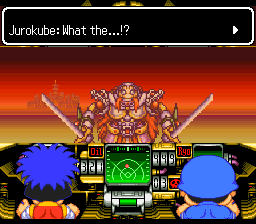

The actual Impact fights were the best so far. They were a lot quicker so reacting and getting in good hits and coin shots felt really good. You can now charge up your punch by just waiting for the power gauge to fill up and charge up your coin shot by holding the button down. It made for less than conventional ways to hold the controller when I decided that I needed to be doing everything all the time. The only downside to them was that I wanted more and they ended up being easier than the previous games, though mostly because I was fighting the controls less
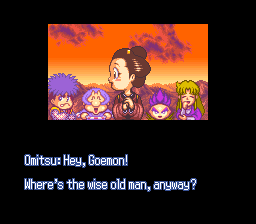
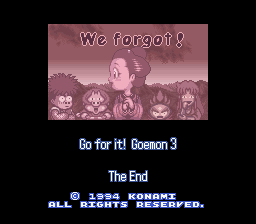
I liked this game too. I can’t help but wish it had started with it’s exploration map section instead of with the two-ish levels you get locked out of, because they create a different kind of expectation for the game that ends up jarring for a few seconds. What it does do though is cement this ‘going on a journey’ thing again, because just like in life, you never know when the levels are gonna stop and the adventure is going to begin.
10) Ganbare Goemon Kirakira Dōchū: Boku ga Dancer ni Natta Wake (1995) (SNES)
The 4th and final game of the main series on the SNES, Ganbare Goemon The Twinkling Journey: The Reason I Became a Dancer. This game gets going before you even have a chance to pick up the controller. After the Konami splash it immediately jumps into an opening cut scene explaining all the exposition we need. Impact isn’t really a mecha and has only been pretending, having been born on the planet Impact. An evil athlete named Seppukumaru has been destroying his home world and Team Goemon is heading there to stop him.
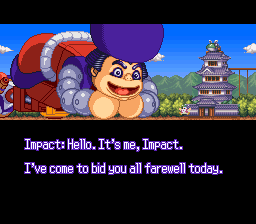




The game immediately splits you up and gives each of our four main characters a planet to explore, broken up into 2 town sections and 4-5 side scrolling action levels. The town sections have that light adventure game element that the last game had but dialed back a bit. Some people will have you do fetch quests from the other town, no more involved than just talking to each person. You’ll be rewarded with upgraded weapons like the ability to charge your coin shots again or Yae turning into a mermaid. You’ll need those upgrades to beat certain parts of certain levels and to help you find three hidden cat statues per-planet that increase your life by one.
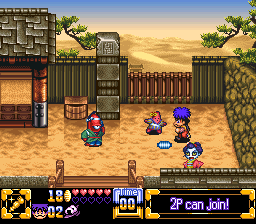



There’s a contest in Ebisumaru’s level where he is trying to bring more attractive ladies to a tree than his purple counterpart, Obisumaru. You have to walk around town and revisit all the houses of the pretty aliens you got while avoiding the less savory ones. You also have to be careful on the street to not run into anyone unattractive. Sasuke has a similar mini game but it involves delivering papers in a time limit to subscribers, and if you go into the wrong house you’ll get your ear talked off through eight or so text boxes.
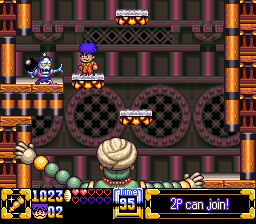


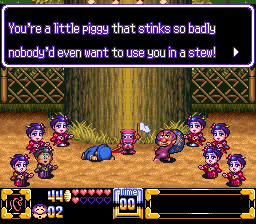
If the last Goemon was ‘precise and a little unforgiving’ this one is like performing surgery. It’s easily the hardest one so far with some very precise jumps required to make it through some of the longer levels (looking directly at Goemon’s baseball catastrophes). It also has moments where it seems somewhat aware of how hard it is. Generally, checkpoints from elephant statues happen every screen or so, so even when a section is grueling you know it isn’t always going to be a huge endurance. The penalty for getting a Game Over is minimal at best, cutting your money in half (which I didn’t use that often anyway), but still letting you start at your last checkpoint from the level you were on. Without that abundance of statues, I might still be playing parts of this.

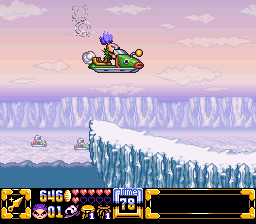

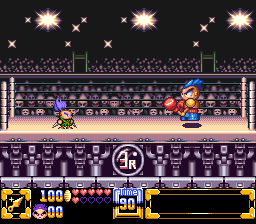

Every boss fight with Seppukumaru’s little riceballs was it’s own weird mini-game with it’s own weird set of rules. One of them involves a roller skating race, another has you catching a sword swing from space. It also features the hardest and most aggressive version of Puyo-Puyo I’ve encountered. It’s interesting but overall feels very disjointed to everything else. The reason you lose to these boss battles isn’t because the skill you’ve been honing the entire time wasn’t enough, but because you have no idea what the fuck is going on until you’ve done it a few times. It’s a much less rewarding feeling than it could have been with traditional boss battles, so I feel a little less rewarded here.

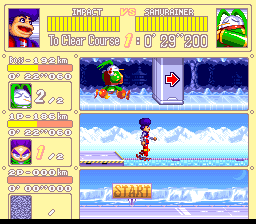


Seppukumaru is the best at all sports except for one: the sport of Seppuku. He hasn’t mastered it because it would mean losing his own life, and all the onigiri bosses we’ve been fighting have been trying to convince him to not ‘take the seppuku challenge’. Also, for reasons never explained, Seppukumaru has a bomb inside of him so if he does commit Seppuku he’ll blow up the whole planet. So we throw him into the Sun instead, and in the aftermath of that Goemon Impacts’ hair gets messed up so Goemon tells him he looks like he could perform in an interplanetary dance troupe, and that’s The Reason [I] Became a Dancer.



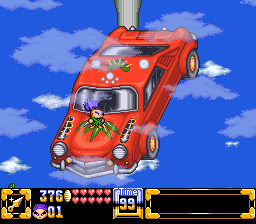

This game was still fun and had some of the prettiest levels in the series, but also some of the ugliest, with one level in particular being a textured nightmare mess. I’d still say check this one out, even if only to confirm to me that ‘oh yeah, it actually is a little harder than it should be, huh?’
Hey now, 10 out of 25 is like… some fraction that’s… uhh, not quite halfway there.. I guess..
huh..
I need to lay down for a bit, I think.